Page 523 of 588
5239-1. Specifications
9
Vehicle specifications
Cooling system
Capacity
1UR-FE
engine
Vehicles without towing package
11.4 qt. (10.8 L, 9.5 Imp.qt.)
Vehicles with towing package
12.6 qt. (11.9 L, 10.5 Imp.qt.)
3UR-FE,
3UR-FBE
enginesVehicles without towing package
11.4 qt. (10.8 L, 9.5 Imp.qt.)
Vehicles with towing package
12.4 qt. (11.7 L, 10.3 Imp.qt.)
Coolant typeUse either of the following.
• “Toyota Super Long Life Coolant”
• Similar high-quality ethylene glycol-
based non-silicate, non-amine, non-
nitrite, and non-borate coolant with
long-life hybrid organic acid technology
Do not use plain water alone.
Ignition system
Spark plug
MakeDENSO SK20HR11
Gap0.043 in. (1.1 mm)
NOTICE
■ Iridium-tipped spark plugs
Use only iridium-tipped spark plugs. Do not adjust the spark plug gap.
Page 524 of 588
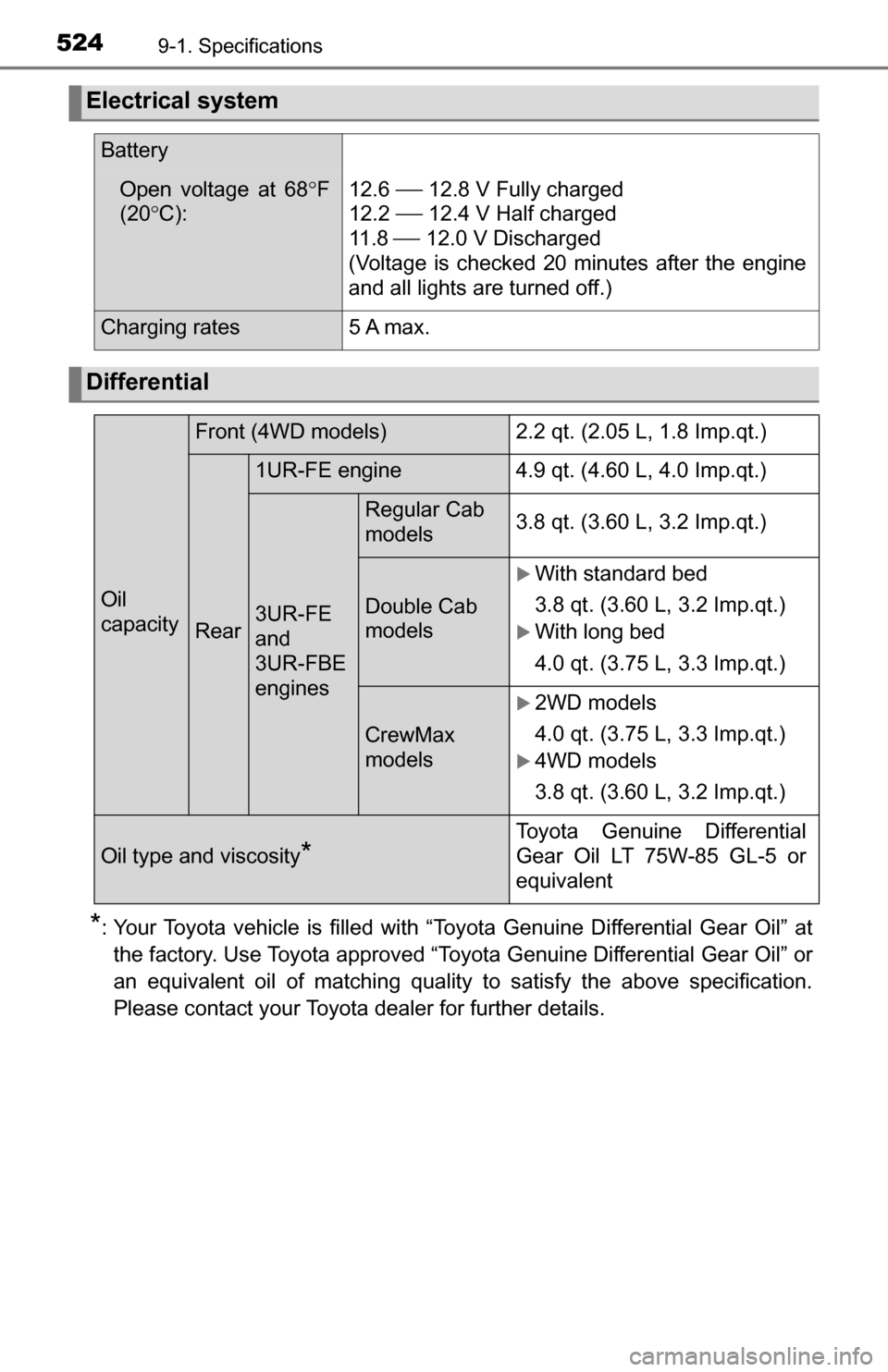
5249-1. Specifications
*: Your Toyota vehicle is filled with “Toyota Genuine Differential Gear Oil” atthe factory. Use Toyota approved “Toyota Genuine Differential Gear Oil” or
an equivalent oil of matching quality to satisfy the above specification.
Please contact your Toyota dealer for further details.
Electrical system
Battery
Open voltage at 68 F
(20 C):12.6 12.8 V Fully charged
12.2
12.4 V Half charged
11 . 8
12.0 V Discharged
(Voltage is checked 20 minutes after the engine
and all lights are turned off.)
Charging rates5 A max.
Differential
Oil
capacity
Front (4WD models) 2.2 qt. (2.05 L, 1.8 Imp.qt.)
Rear
1UR-FE engine4.9 qt. (4.60 L, 4.0 Imp.qt.)
3UR-FE
and
3UR-FBE
engines
Regular Cab
models3.8 qt. (3.60 L, 3.2 Imp.qt.)
Double Cab
models
With standard bed
3.8 qt. (3.60 L, 3.2 Imp.qt.)
With long bed
4.0 qt. (3.75 L, 3.3 Imp.qt.)
CrewMax
models
2WD models
4.0 qt. (3.75 L, 3.3 Imp.qt.)
4WD models
3.8 qt. (3.60 L, 3.2 Imp.qt.)
Oil type and viscosity*
Toyota Genuine Differential
Gear Oil LT 75W-85 GL-5 or
equivalent
Page 525 of 588
5259-1. Specifications
9
Vehicle specifications
*: The fluid capacity is the quantity of reference. If replacement is necessary, contact your Toyota dealer.
Automatic transmission
Fluid
capac-
ity
*
1UR-FE engine
2WD models
11.6 qt. (11.0 L, 9.7 Imp.qt.)
4WD models
11.3 qt. (10.7 L, 9.4 Imp.qt.)
3UR-FE
and
3UR-FBE
enginesVehicles without
towing package 11.7 qt. (11.1 L, 9.8 Imp.qt.)
Vehicles with
towing package12.3 qt. (11.6 L, 10.2 Imp.qt.)
Fluid type
Toyota Genuine ATF WS
NOTICE
■Transmission fluid type
Using transmission fluid other than “Toyota Genuine ATF WS” may cause
deterioration in shift quality, locking up of the transmission accompanied by
vibration and, ultimately, damage to the vehicle’s transmission.
Transfer (4WD models)
Oil capacity 1.6 qt. (1.5 L, 1.3 Imp.qt.)
Oil typeToyota Genuine Transfer Gear oil LF or
equivalent
Recommended oil viscosity SAE 75W
Page 526 of 588
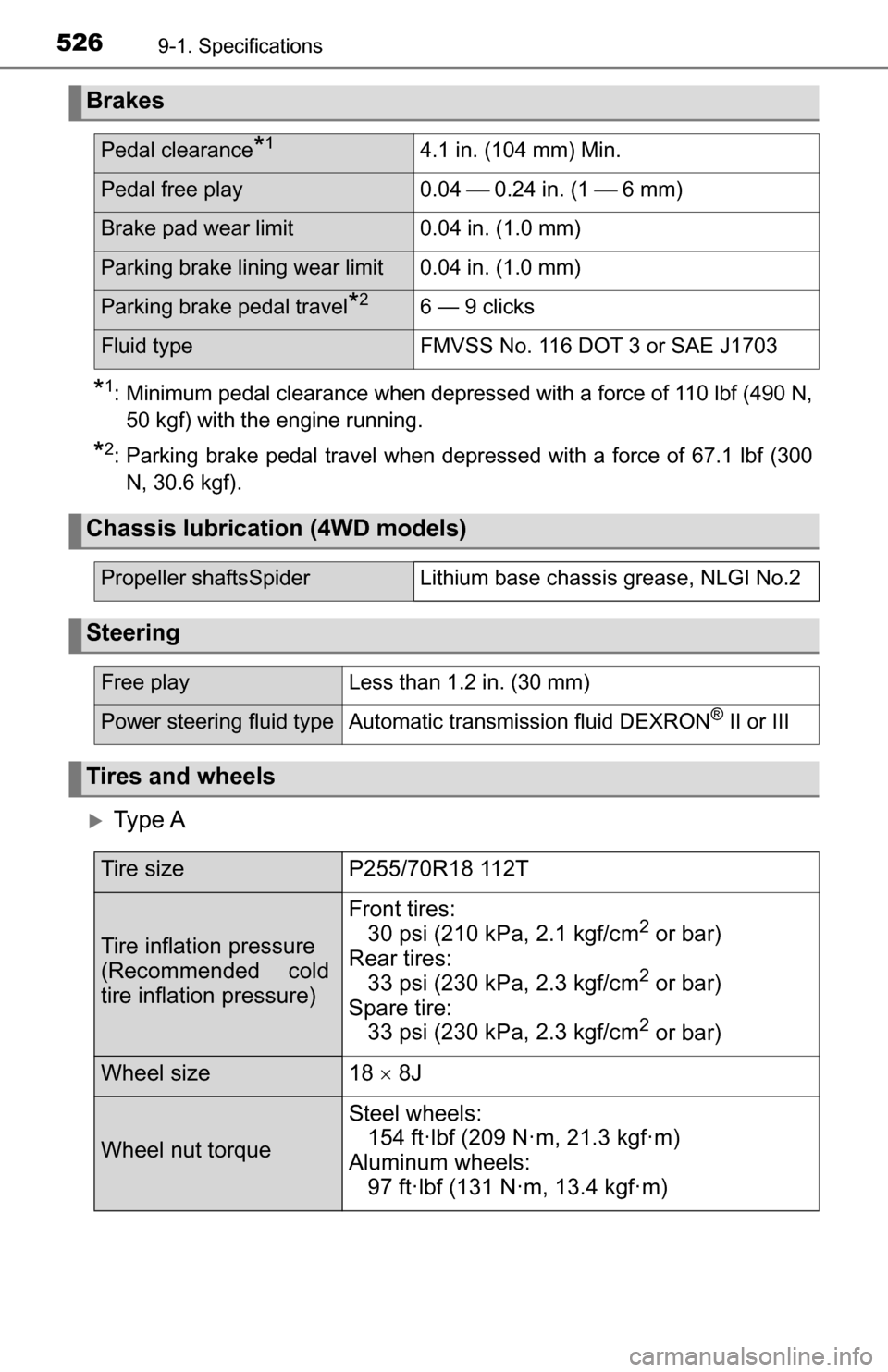
5269-1. Specifications
*1: Minimum pedal clearance when depressed with a force of 110 lbf (490 N,
50 kgf) with the engine running.
*2: Parking brake pedal travel when depressed with a force of 67.1 lbf (300 N, 30.6 kgf).
Ty p e A
Brakes
Pedal clearance*14.1 in. (104 mm) Min.
Pedal free play 0.04 0.24 in. (1 6 mm)
Brake pad wear limit0.04 in. (1.0 mm)
Parking brake lining wear limit 0.04 in. (1.0 mm)
Parking brake pedal travel*26 — 9 clicks
Fluid type FMVSS No. 116 DOT 3 or SAE J1703
Chassis lubrication (4WD models)
Propeller shaftsSpider Lithium base chassis grease, NLGI No.2
Steering
Free playLess than 1.2 in. (30 mm)
Power steering fluid typeAutomatic transmission fluid DEXRON® II or III
Tires and wheels
Tire sizeP255/70R18 112T
Tire inflation pressure
(Recommended cold
tire inflation pressure)
Front tires:
30 psi (210 kPa, 2.1 kgf/cm2 or bar)
Rear tires: 33 psi (230 kPa, 2.3 kgf/cm
2 or bar)
Spare tire: 33 psi (230 kPa, 2.3 kgf/cm
2 or bar)
Wheel size18 8J
Wheel nut torque
Steel wheels:
154 ft·lbf (209 N·m, 21.3 kgf·m)
Aluminum wheels: 97 ft·lbf (131 N·m, 13.4 kgf·m)
Page 529 of 588
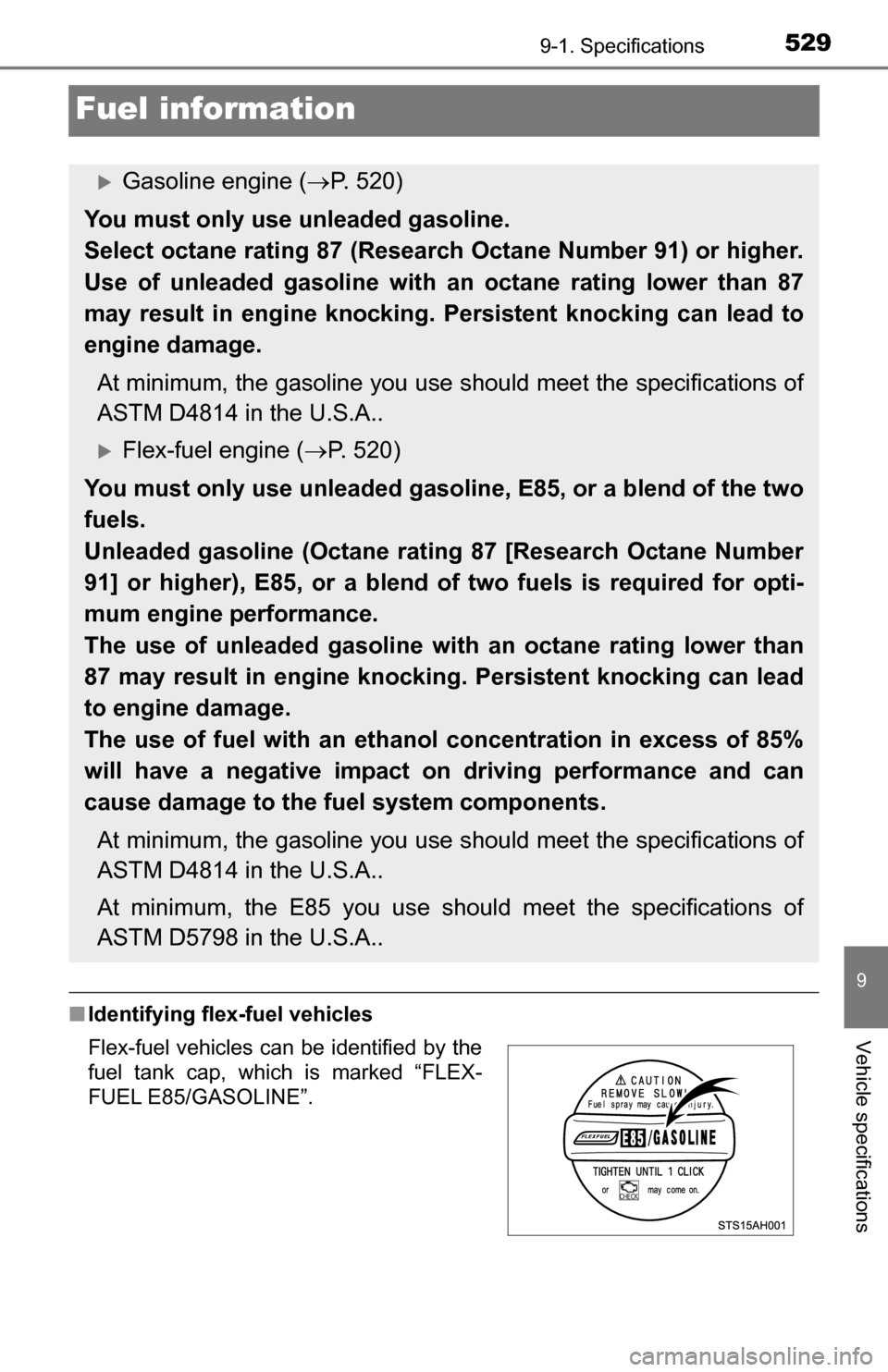
5299-1. Specifications
9
Vehicle specifications
Fuel information
■Identifying flex-fuel vehicles
Gasoline engine ( P. 520)
You must only use unleaded gasoline.
Select octane rating 87 (Research Octane Number 91) or higher.
Use of unleaded gasoline with an octane rating lower than 87
may result in engine knocking. Persistent knocking can lead to
engine damage.
At minimum, the gasoline you use s hould meet the specifications of
ASTM D4814 in the U.S.A..
Flex-fuel engine ( P. 520)
You must only use unleaded gasoline, E85, or a blend of the two
fuels.
Unleaded gasoline (Octane rating 87 [Research Octane Number
91] or higher), E85, or a blend of two fuels is required for opti-
mum engine performance.
The use of unleaded gasoline with an octane rating lower than
87 may result in engine knocki ng. Persistent knocking can lead
to engine damage.
The use of fuel with an ethanol concentration in excess of 85%
will have a negative impact on driving performance and can
cause damage to the fuel system components.
At minimum, the gasoline you use s hould meet the specifications of
ASTM D4814 in the U.S.A..
At minimum, the E85 you use s hould meet the specifications of
ASTM D5798 in the U.S.A..
Flex-fuel vehicles can be identified by the
fuel tank cap, which is marked “FLEX-
FUEL E85/GASOLINE”.
Page 530 of 588
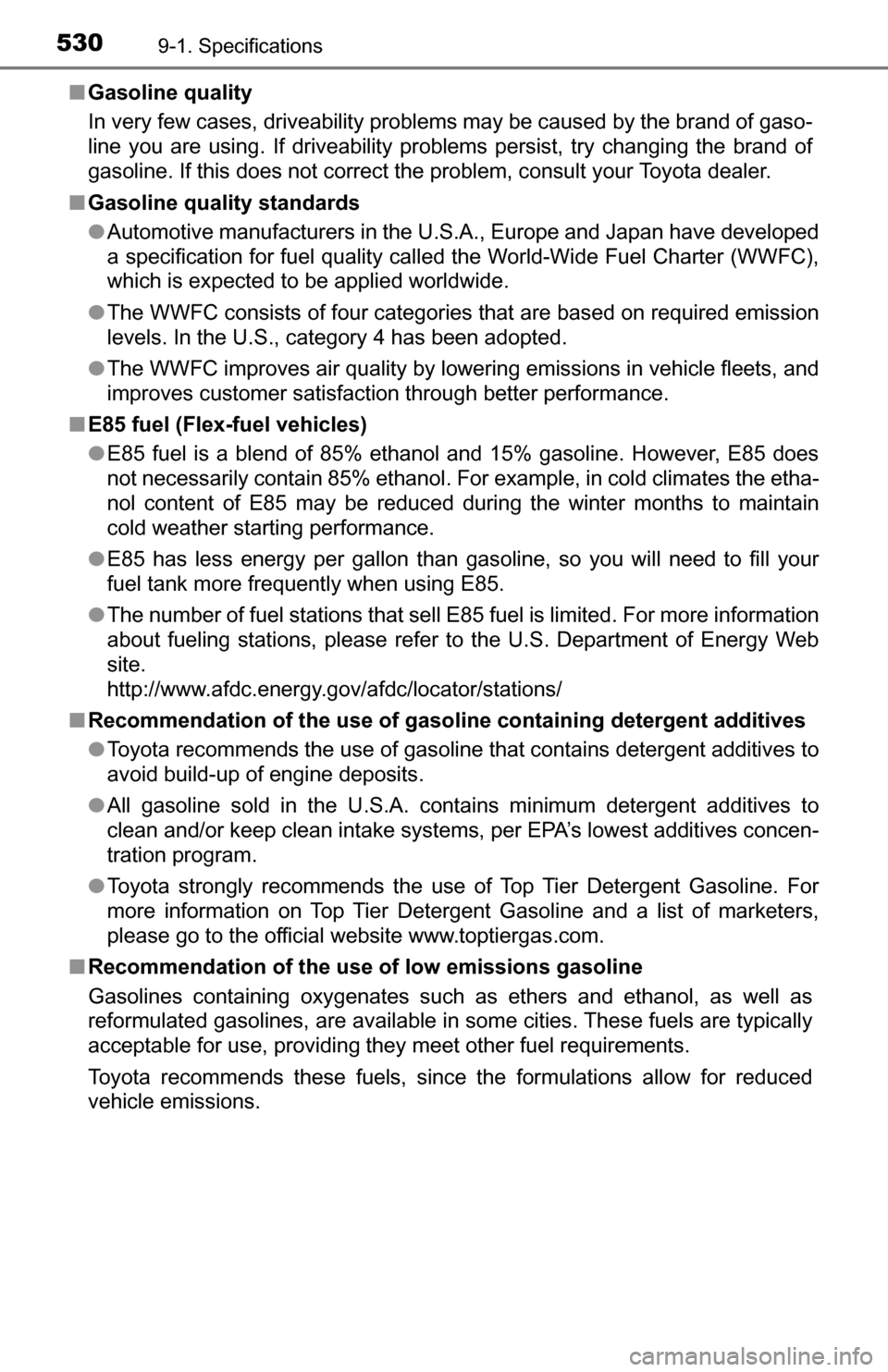
5309-1. Specifications
■Gasoline quality
In very few cases, driveability problems may be caused by the brand of gaso-
line you are using. If driveability problems persist, try changing the brand of
gasoline. If this does not correct the problem, consult your Toyota dealer.
■ Gasoline quality standards
●Automotive manufacturers in the U.S.A., Europe and Japan have developed
a specification for fuel quality called the World-Wide Fuel Charter (WWFC),
which is expected to be applied worldwide.
● The WWFC consists of four categor ies that are based on required emission
levels. In the U.S., category 4 has been adopted.
● The WWFC improves air quality by lowering emissions in vehicle fleets, and
improves customer satisfaction through better performance.
■ E85 fuel (Flex-fuel vehicles)
●E85 fuel is a blend of 85% ethanol and 15% gasoline. However, E85 does
not necessarily contain 85% ethanol. For example, in cold climates the etha-
nol content of E85 may be reduced during the winter months to maintain
cold weather starting performance.
● E85 has less energy per gallon than gasoline, so you will need to fill your
fuel tank more frequently when using E85.
● The number of fuel stations that sell E85 fuel is limited. For more information
about fueling stations, please refer to the U.S. Department of Energy Web
site.
http://www.afdc.energy.gov/afdc/locator/stations/
■ Recommendation of the use of gaso line containing detergent additives
● Toyota recommends the use of gasoline that contains detergent additives to
avoid build-up of engine deposits.
● All gasoline sold in the U.S.A. contains minimum detergent additives to
clean and/or keep clean intake systems, per EPA’s lowest additives concen-
tration program.
● Toyota strongly recommends the use of Top Tier Detergent Gasoline. For
more information on Top Tier Detergent Gasoline and a list of marketers,
please go to the official website www.toptiergas.com.
■ Recommendation of the use of low emissions gasoline
Gasolines containing oxygenates such as ethers and ethanol, as well as
reformulated gasolines, are available in some cities. These fuels are typically
acceptable for use, providing they meet other fuel requirements.
Toyota recommends these fuels, since the formulations allow for reduced
vehicle emissions.
Page 531 of 588
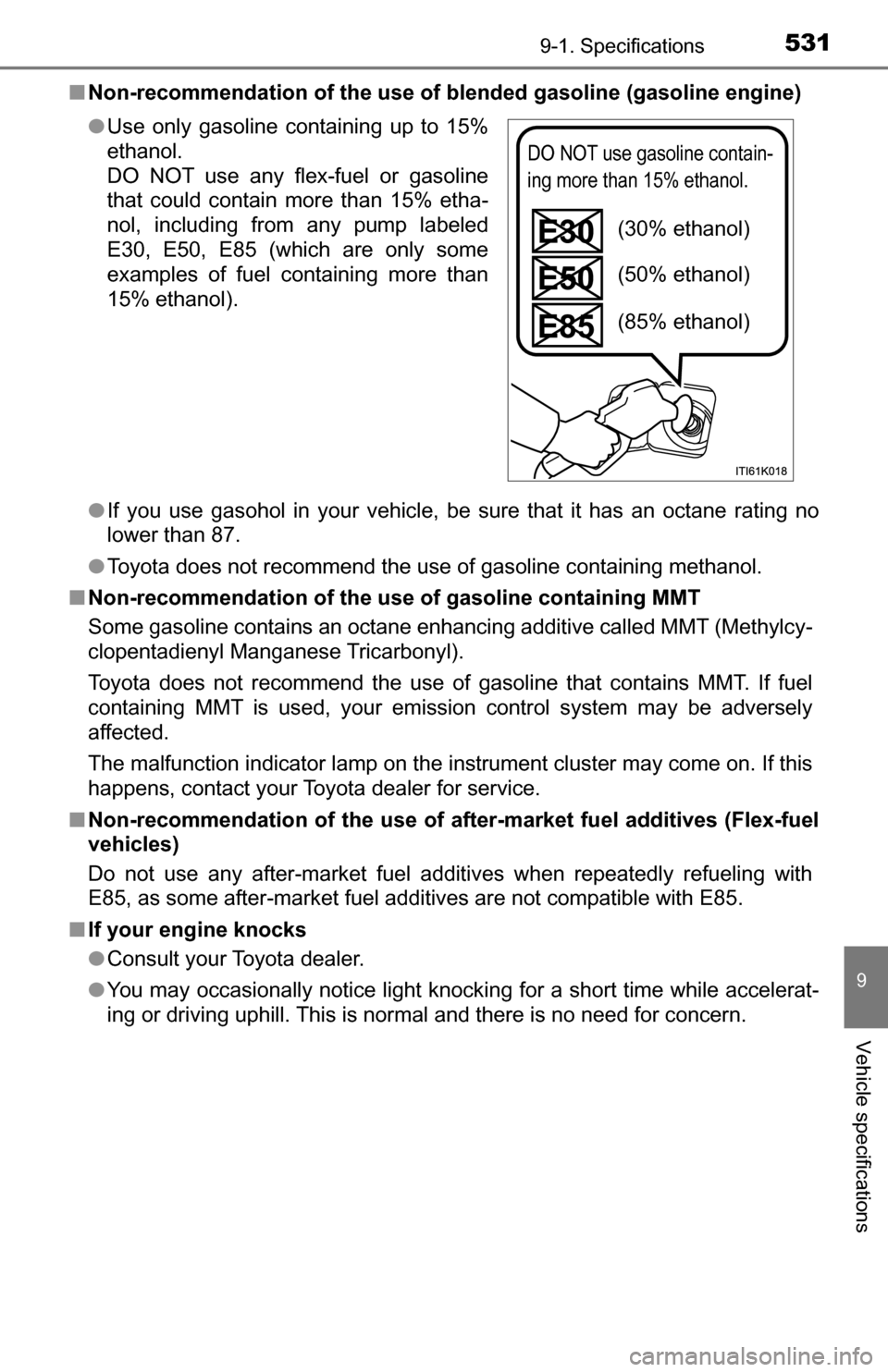
5319-1. Specifications
9
Vehicle specifications
■Non-recommendation of the use of blended gasoline (gasoline engine)
●If you use gasohol in your vehicle, be sure that it has an octane rating no
lower than 87.
● Toyota does not recommend the use of gasoline containing methanol.
■ Non-recommendation of the use of gasoline containing MMT
Some gasoline contains an octane enhancing additive called MMT (Methylcy-
clopentadienyl Manganese Tricarbonyl).
Toyota does not recommend the use of gasoline that contains MMT. If fuel
containing MMT is used, your emission control system may be adversely
affected.
The malfunction indicator lamp on the instrument cluster may come on. If this
happens, contact your Toyota dealer for service.
■ Non-recommendation of the use of after-market fuel additives (Flex-fuel
vehicles)
Do not use any after-market fuel additives when repeatedly refueling with
E85, as some after-market fuel additives are not compatible with E85.
■ If your engine knocks
●Consult your Toyota dealer.
● You may occasionally notice light knocking for a short time while accelerat-
ing or driving uphill. This is normal and there is no need for concern.
●
Use only gasoline containing up to 15%
ethanol.
DO NOT use any flex-fuel or gasoline
that could contain more than 15% etha-
nol, including from any pump labeled
E30, E50, E85 (which are only some
examples of fuel containing more than
15% ethanol).
DO NOT use gasoline contain-
ing more than 15% ethanol.
(30% ethanol)
(50% ethanol)
(85% ethanol)
Page 532 of 588
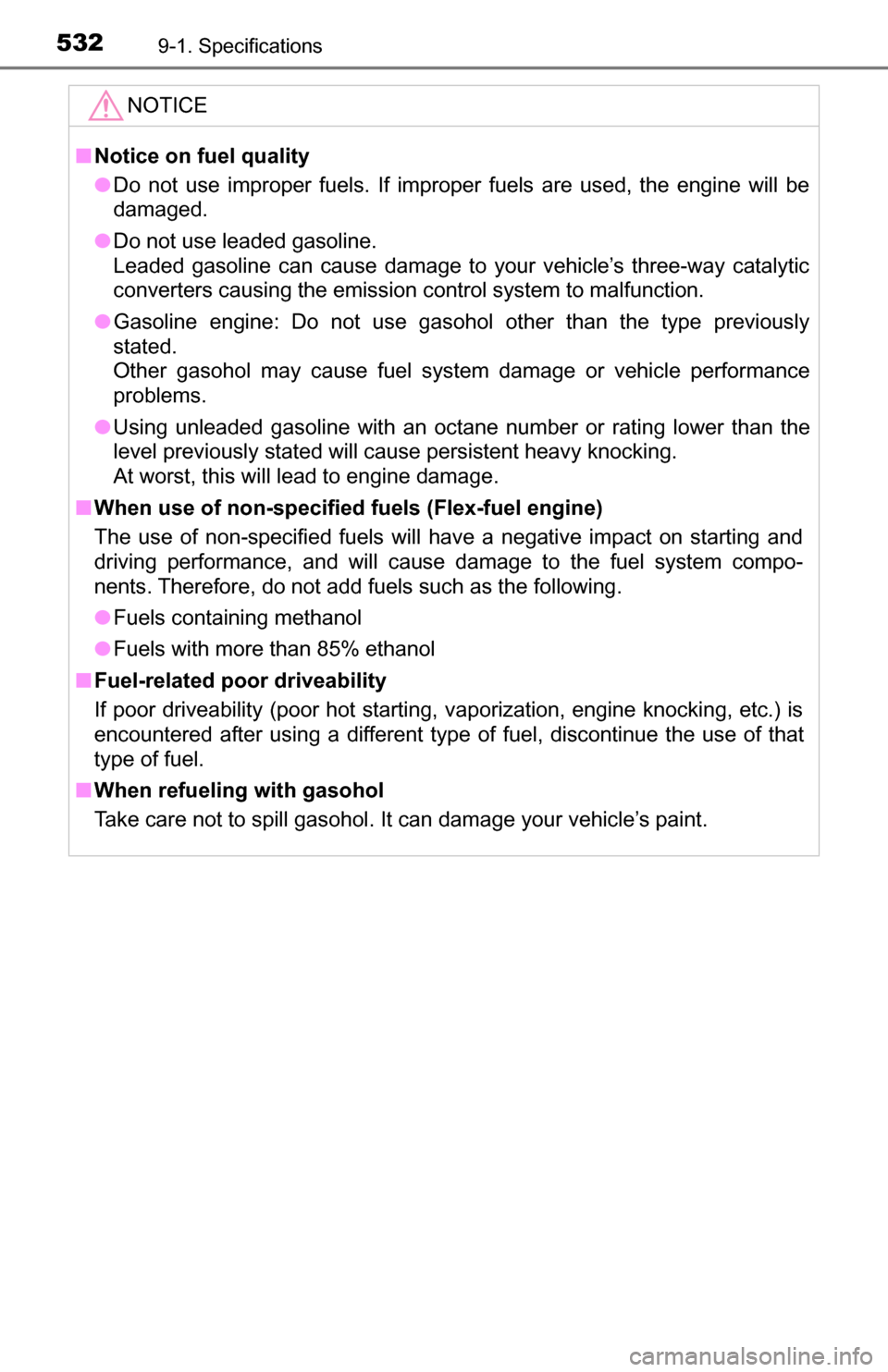
5329-1. Specifications
NOTICE
■Notice on fuel quality
● Do not use improper fuels. If improper fuels are used, the engine will be
damaged.
● Do not use leaded gasoline.
Leaded gasoline can cause damage to your vehicle’s three-way catalytic
converters causing the emission control system to malfunction.
● Gasoline engine: Do not use gasohol other than the type previously
stated.
Other gasohol may cause fuel system damage or vehicle performance
problems.
● Using unleaded gasoline with an octane number or rating lower than the
level previously stated will cause persistent heavy knocking.
At worst, this will lead to engine damage.
■ When use of non-specified fuels (Flex-fuel engine)
The use of non-specified fuels will have a negative impact on starting and
driving performance, and will cause damage to the fuel system compo-
nents. Therefore, do not add fuels such as the following.
● Fuels containing methanol
● Fuels with more than 85% ethanol
■ Fuel-related poor driveability
If poor driveability (poor hot starting, vaporization, engine knocking, etc.) is
encountered after using a different type of fuel, discontinue the use of that
type of fuel.
■ When refueling with gasohol
Take care not to spill gasohol. It can damage your vehicle’s paint.